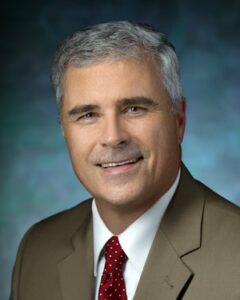Takeaway
Medical school traditions and ceremonies are to be cherished and appreciated. They also provide educators with an opportunity to reflect on the importance of teaching and mentoring.

Passion in the Medical Profession | June 26, 2024 | 2 min read
By Richard Schaefer, MD, MPH, Johns Hopkins Medicine
In 1993, the Arnold P. Gold Foundation started the White Coat Ceremony for medical students in order to emphasize the importance of compassionate patient care. Our medical school recently held its annual White Coat Ceremony for the first-year students. It was a wonderful affair, with inspiring speeches, moving musical performances, the reading of the students’ statement of values, and of course, the cloaking of the students with their new white coats.
As a faculty advisor, I had the distinct honor of performing that cloaking for my five mentees. Placing the white coat on their shoulders was symbolic of welcoming them as student colleagues in medicine.
The line of white coats in the auditorium also reminded me of the “The Long Gray Line” of West Point, my alma mater. West Point cadets wear traditional gray uniforms, and the “Long Gray Line” is an expression that symbolizes the link between cadets and graduates, living and deceased. I thought of a similar link between physicians, past and present, with these future physicians. A link representing the continuum of medicine, with values handed down since the time of Hippocrates.
It was indeed an honor to be part of the White Coat Ceremony, to have the privilege of cloaking my students. The ceremony was also a reminder of my responsibility to be a role model, to set an example of professionalism, clinical excellence, and joy in this beautiful profession of medicine.
“‘I desire no other epitaph . . . than the statement that I taught medical students in the wards, as I regard this as by far the most useful and important work I have been called upon to do.”—Sir William Osler
“The successful teacher is no longer on a height . . . but he is a senior student anxious to help his juniors. When a simple, earnest spirit animates a college, there is no appreciable interval between the teacher and the taught—both are in the same class, the one a little more advanced than the other. So animated, the student feels that he has joined a family whose honour is his honour, whose welfare is his own, and whose interests should be his first consideration.”—Sir William Osler
Acknowledgments: Tihitina Aytenfisu, Shreya Daniel, Sara Khoshniyati, Skylar Mackay, Kyle Patel, and all the medical students I’ve had the privilege to teach.
This piece expresses the views solely of the author. It does not represent the views of any organization, including Johns Hopkins Medicine.

